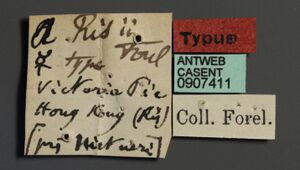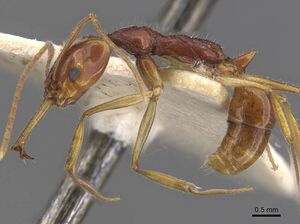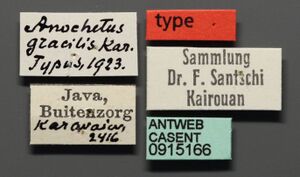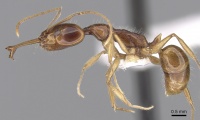Anochetus risii
| Anochetus risii | |
|---|---|

| |
| Scientific classification | |
| Kingdom: | Animalia |
| Phylum: | Arthropoda |
| Class: | Insecta |
| Order: | Hymenoptera |
| Family: | Formicidae |
| Subfamily: | Ponerinae |
| Tribe: | Ponerini |
| Genus: | Anochetus |
| Species: | A. risii |
| Binomial name | |
| Anochetus risii Forel, 1900 | |
| Synonyms | |
| |
Biological information about A. risii is limited to a few sparse specimen records with collection information, "leaf litter" and "under Ficus".
Identification
Brown (1978) – Ferruginous yellow in color, with pale yellow legs; the pronotum is striate or rugulose in front and around the sides of the disc, but the center of the disc is smooth and shining. In A. risii and related species, the dorsal inner margin of the mandible is nearly straight and is edentate with a smooth margin, the preapical angle tends to be acute and is directed somewhat apicad as well as mesad, and the intercalary tooth of the apical trio is reduced and situated far out on the ventral apical tooth near its apex, which may thus appear furcate in young specimens. In older specimens, the intercalary tooth may be worn to a nub, or broken off, and scarcely detectable. A representative worker from Kusang, China has HL 1.62, HW 1.44, ML 1.19, scape L 1.58, eye L 0.28 mm; CI 89, MI 73.
Keys including this Species
- Key to the Anochetus Species of Asia, Melanesia and the Pacific Region
- Key to Chinese species of Anochetus
Distribution
Latitudinal Distribution Pattern
Latitudinal Range: 25° to 13°.
| North Temperate |
North Subtropical |
Tropical | South Subtropical |
South Temperate |
- Source: AntMaps
Distribution based on Regional Taxon Lists
Indo-Australian Region: Indonesia.
Oriental Region: Taiwan (type locality), Vietnam.
Palaearctic Region: China (type locality).
Distribution based on AntMaps
Distribution based on AntWeb specimens
Check data from AntWeb
Countries Occupied
| Number of countries occupied by this species based on AntWiki Regional Taxon Lists. In general, fewer countries occupied indicates a narrower range, while more countries indicates a more widespread species. |

|
Estimated Abundance
| Relative abundance based on number of AntMaps records per species (this species within the purple bar). Fewer records (to the left) indicates a less abundant/encountered species while more records (to the right) indicates more abundant/encountered species. |

|
Biology
Castes
Worker
Images from AntWeb
   
| |
| Syntype of Anochetus risii. Worker. Specimen code casent0907411. Photographer Z. Lieberman, uploaded by California Academy of Sciences. | Owned by MHNG, Geneva, Switzerland. |
   
| |
| Syntype of Anochetus gracilis. Worker. Specimen code casent0915166. Photographer Will Ericson, uploaded by California Academy of Sciences. | Owned by NHMB, Basel, Switzerland. |
Nomenclature
The following information is derived from Barry Bolton's Online Catalogue of the Ants of the World.
- risii. Anochetus risii Forel, 1900c: 60 (w.) CHINA (Hong Kong).
- Type-material: syntype workers (number not stated).
- Type-locality: China: Hong Kong, Victoria Peak (F. Ris).
- Type-depository: MHNG.
- Wheeler, W.M. 1927h: 84 (m.); Wheeler, W.M. 1928c: 8 (q.).
- Status as species: Emery, 1911d: 109; Wheeler, W.M. 1927d: 2; Wheeler, W.M. 1927h: 84; Wheeler, W.M. 1928c: 8; Wheeler, W.M. 1930h: 61; Chapman & Capco, 1951: 41; Brown, 1978c: 558, 577; Wang, M. 1993a: 226 (in key); Bolton, 1995b: 65; Tang, J., Li, et al. 1995: 30; Zhou, 2001b: 29; Zhou & Ran, 2010: 103; Guénard & Dunn, 2012: 58; Chen, Z., Yang & Zhou, 2019: 64 (redescription).
- Senior synonym of taiwaniensis: Chen, Z., Yang & Zhou, 2019: 64.
- Distribution: China, Taiwan, Vietnam.
- taiwaniensis. Anochetus taiwaniensis Terayama, 1989a: 26, figs. 1-6 (w.) TAIWAN.
- Type-material: holotype worker, 66 paratype workers.
- Type-locality: holotype Taiwan: Kaohsiung Hsien, Liukuei, 17.viii.1987 (S. Kubota); paratypes: 45 workers with same data, 10 workers with same data but (H. Sakai), 10 workers with same data but (M. Terayama), 1 worker Taiwan: Taipei Hsien, Wulai, 2.viii.1981 (S. Kubota).
- Type-depositories: NIAS (holotype); NIAS, TARI (paratypes).
- Status as species: Wang, M. 1993a: 226 (in key); Bolton, 1995b: 66; Lin & Wu, 2003: 67; Terayama, 2009: 116; Zhou & Ran, 2010: 103; Leong, Tsai, et al. 2018: 128 (in key).
- Junior synonym of risii: Chen, Z., Yang & Zhou, 2019: 64.
Unless otherwise noted the text for the remainder of this section is reported from the publication that includes the original description.
Description
Worker
Chen et al. (2019) - TL 5.12–5.34, HL 1.67–1.69, HW 1.44–1.46, CI 85–87, SL 1.55– 1.57, SI 106–108, ED 0.11–0.12, PW 0.80–0.82, MSL 2.33–2.36, PL 0.37–0.39, PH 0.74–0.76, DPW 0.30–0.32, LPI 202–207, DPI 83–85 (n = 5).
In full-face view head longer than broad, posterior margin strongly concave. Mandibles linear, gradually broadened apically; inner margin with several denticles, gradually decreasing in size towards base; apical portion with three distinct teeth. Antennae 12-segmented; scapes surpassing to posterior corners of head by about 1/5 of its length. Eyes large, maximum diameter of eye wider than the basal width of mandibles. In lateral view mesosoma slender. Pronotum weakly convex. Promesonotal suture shallowly impressed. Mesonotum weakly convex, sloping posteriorly. Metanotal groove deeply concave. Dorsum of propodeum almost straight, posterodorsal corner bluntly angled. Petiole cone-shaped and slightly inclined posteriorly, with a pointed dorsal apex, anterior margin weakly convex, posterior margin almost straight; subpetiolar process triangular, directed posteroventrally.
Frons longitudinally to obliquely striate posteriorly; frontal lobes and clypeus weakly striate, remainder of head smooth and shining. Mesosoma smooth and shining, propodeum and lower part of metapleuron obliquely rugose. Sometimes sides of pronotum weakly longitudinal rugose. Petiole smooth and shining, basal area weakly striate. Gaster smooth and shining. Body dorsum with abundant erect to suberect hairs and dense decumbent pubescence; scapes and tibiae with scattered suberect hairs and dense decumbent pubescence. Body blackish brown; antennae and legs yellowish brown.
References
- Brassard, F., Leong, C.-M., Chan, H.-H., Guénard, B. 2021. High diversity in urban areas: How comprehensive sampling reveals high ant species richness within one of the most urbanized regions of the world. Diversity 13, 358 (doi:10.3390/d13080358).
- Brown, W. L., Jr. 1978c. Contributions toward a reclassification of the Formicidae. Part VI. Ponerinae, tribe Ponerini, subtribe Odontomachiti. Section B. Genus Anochetus and bibliography. Studia Entomologica. 20:549-638. (page 558, senior synonym of gracilis)
- Chen, Z., Yang, Z., Zhou, S. 2019. Review of the ant genus Anochetus Mayr, 1861 (Hymenoptera, Formicidae) from China, with revival of the valid status of Anochetus gracilis. Journal of Hymenoptera Research 68: 49–74 (DOI 10.3897/jhr.68.30784).
- Dendup, K.C., Dorji, C., Dhadwal, T., Bharti, H., Pfeiffer, M. 2021. A preliminary checklist of ants from Bhutan. Asian Myrmecology 14, e014005 (doi:10.20362/am.014005).
- Forel, A. 1900d. Les Formicides de l'Empire des Indes et de Ceylan. Part VI. The Journal of the Bombay Natural History Society. 13:52-65. (page 60, worker described)
- Liu, C., Fischer, G., Hita Garcia, F., Yamane, S., Liu, Q., Peng, Y.Q., Economo, E.P., Guénard, B., Pierce, N.E. 2020. Ants of the Hengduan Mountains: a new altitudinal survey and updated checklist for Yunnan Province highlight an understudied insect biodiversity hotspot. ZooKeys 978, 1–171 (doi:10.3897/zookeys.978.55767).
- Ngô-Muller V., Garrouste R., Schubnel T., Pouillon J.-M., Christophersen V., Christophersen N., Nel A. 2021. The first representative of the trap-jaw ant genus Anochetus Mayr, 1861 in Neogene amber from Sumatra (Hymenoptera: Formicidae). Comptes Rendus Palevol 20(2): 21-27 (doi:10.5852/cr-palevol2021v20a2).
- Radchenko, A.G., Fisher, B.L., Esteves, F.A., Martynova, E.V., Bazhenova, T.N., Lasarenko, S.N. 2023. Ant type specimens (Hymenoptera, Formicidae) in the collection of Volodymyr Opanasovych Karawajew. Communication 1. Dorylinae, Poneromorpha and Pseudomyrmecinae. Zootaxa, 5244(1), 1–32 (doi:10.11646/zootaxa.5244.1.1).
- Wheeler, W. M. 1927h. Ants collected by Professor F. Silvestri in Indochina. Boll. Lab. Zool. Gen. Agrar. R. Sc. Super. Agric. 20: 83-106 (page 84, male described)
- Wheeler, W. M. 1928c. Ants collected by Professor F. Silvestri in China. Boll. Lab. Zool. Gen. Agrar. R. Sc. Super. Agric. 22: 3-38 (page 8, queen described)
References based on Global Ant Biodiversity Informatics
- Brown Jr., W.L. 1978. Contributions toward a reclassification of the Formicidae. Part VI. Ponerinae, Tribe Ponerini, Subtribe Odontomachiti, Section B. Genus Anochetus and Bibliography. Studia Entomologia 20(1-4): 549-XXX
- CSIRO Collection
- Chapman, J. W., and Capco, S. R. 1951. Check list of the ants (Hymenoptera: Formicidae) of Asia. Monogr. Inst. Sci. Technol. Manila 1: 1-327
- Chen Z., Z. Yang, and S. Zhou. 2019. Review of the ant genus Anochetus Mayr, 1861 (Hymenoptera, Formicidae) from China, with revival of the valid status of Anochetus gracilis. Journal of Hymenoptera Research 68: 49–74.
- Cheng D., Z. Chen, and S. Zhou. 2015. An analysis on the ant fauna of Jinzhongshan Nature Reserve in Gunagxi, China. Journal of Guangxi Normal University: Natural Science Edition 33(3): 129.137.
- Emery C. 1911. Hymenoptera. Fam. Formicidae. Subfam. Ponerinae. Genera Insectorum 118: 1-125.
- Fellowes J. R., and D. Dudgeon. 2003. Common ants of lowland forests in Hong Kong, Tropical China. Proceedings of the 2nd ANeT Workshop and Seminar, p. 19-43.
- Forel A. 1900. Les Formicides de l'Empire des Indes et de Ceylan. Part VI. J. Bombay Nat. Hist. Soc. 13: 52-65.
- Guénard B., and R. R. Dunn. 2012. A checklist of the ants of China. Zootaxa 3558: 1-77.
- Kadoorie Farm and Botanic Garden, 2002. Report of Rapid Biodiversity Assessments at Jianling and Shangxi Nature Reserves, Southeast Hainan, China, May 1999. South China Forest Biodiversity Survey Report Series (Online Simplified Version): No. 21. KFBG, Hong Kong SAR, ii + 18 pp.
- Leong C. M., S. F. Shiao, and B. Guenard. 2017. Ants in the city, a preliminary checklist of Formicidae (Hymenoptera) in Macau, one of the most heavily urbanized regions of the world. Asian Myrmecology 9: e009014.
- Li Z.h. 2006. List of Chinese Insects. Volume 4. Sun Yat-sen University Press
- Ogata K. 2005. Asian ant inventory and international networks. Report on Insect inventory Project in Tropic Asia TAIIV: 145-170.
- Staab M., A. Schuldt, T. Assmann, H. Bruelheide, and A.M. Klein. 2014. Ant community structure during forest succession in a subtropical forest in South-East China. Acta Oecologia 61: 32-40.
- Tang J., Li S., Huang E., Zhang B. and Chen Y. 1995. Hymenoptera: Formicidae (1). Economic Insect Fauna of China 47: 1-133.
- Terayama M. 1989. The ant tribe Odontomachini (Hymenoptera: Formicidae) from Taiwan, with a description of a nes species. Edaphologia 40: 25-29.
- Terayama M. 2009. A synopsis of the family Formicidae of Taiwan (Insecta: Hymenoptera). Research Bulletin of Kanto Gakuen University. Liberal Arts 17:81-266.
- Terayama, M. 2009. A synopsis of the family Formicidae of Taiwan (Insecta; Hymenoptera). The Research Bulletin of Kanto Gakuen University 17: 81-266.
- Wheeler W. M. 1927. Ants collected by Professor F. Silvestri in Indochina. Bollettino del Laboratorio di Zoologia Generale e Agraria della Reale Scuola Superiore d'Agricoltura. Portici 20: 83-106.
- Wheeler W. M. 1928. Ants collected by Professor F. Silvestri in China. Bollettino del Laboratorio di Zoologia Generale e Agraria della Reale Scuola Superiore d'Agricoltura. Portici 22: 3-38.
- Wheeler W. M. 1930. A list of the known Chinese ants. Peking Natural History Bulletin 5: 53-81.
- Yamane S.; Bui T. V.; Ogata K.; Okido H.; Eguchi K. 2002. Ant fauna of Cuc Phuong National Park, North Vietnam (Hymenoptera: Formicidae). Bulletin of the Institute of Tropical Agriculture Kyushu University 25: 51-62.
- Zhou S.-Y. 2001. Ants of Guangxi. Guangxi Normal University Press, Guilin, China, Guilin, China. 255 pp.
- Zryanin V. A. 2011. An eco-faunistic review of ants (Hymenoptera: Formicidae). In: Structure and functions of soil communities of a monsoon tropical forest (Cat Tien National Park, southern Vietnam) / A.V. Tiunov (Editor). – M.: KMK Scientific Press. 2011. 277 р.101-124.


